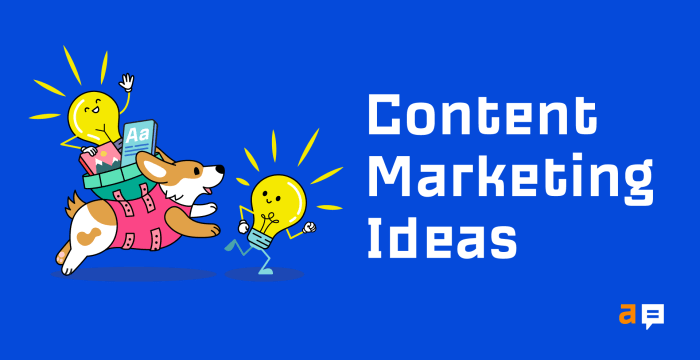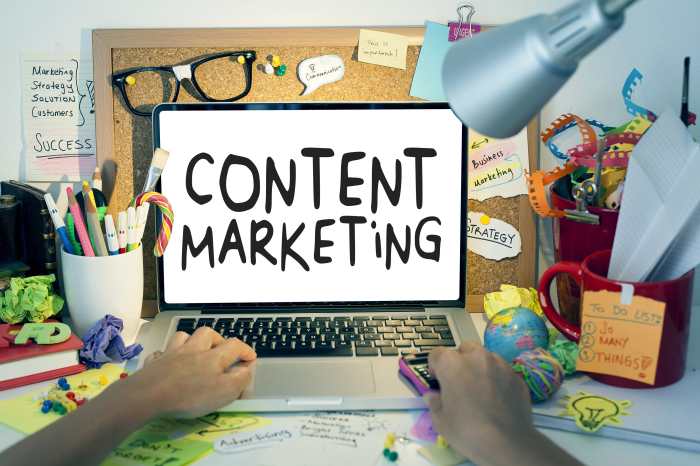Content Marketing Ideas sets the stage for this enthralling narrative, offering readers a glimpse into a story that is rich in detail with American high school hip style and brimming with originality from the outset.
Get ready to dive into a world where successful campaigns, creative tips, powerful storytelling, and innovative content repurposing collide to revolutionize the digital marketing landscape.
Content Marketing Ideas

In the world of content marketing, creativity is key to standing out from the crowd and capturing your audience’s attention. Let’s dive into some successful content marketing campaigns, tips for generating creative ideas, the importance of storytelling, and how to repurpose existing content for new marketing strategies.
Successful Content Marketing Campaigns
- Red Bull’s Stratos Jump: Red Bull sponsored Felix Baumgartner’s record-breaking freefall from the edge of space, creating a thrilling and shareable video that showcased their brand’s adventurous spirit.
- Dove’s Real Beauty Campaign: Dove’s campaign focused on promoting self-confidence and challenging beauty standards, resonating with their audience on a personal level.
- Oreo’s Daily Twist: Oreo celebrated its 100th anniversary with a daily series of creative ads featuring the classic cookie in different scenarios, engaging fans and sparking conversations.
Generating Creative Content Ideas
- Brainstorming Sessions: Gather your team for creative brainstorming sessions to generate fresh and innovative content ideas.
- Research Trends: Stay up-to-date with industry trends and popular topics to inspire your content creation process.
- Cross-Promotion: Collaborate with influencers or other brands to bring new perspectives and ideas to your content strategy.
Importance of Storytelling in Content Marketing
“The most powerful person in the world is the storyteller.”
Steve Jobs
Storytelling is a powerful tool in content marketing that allows brands to connect with their audience on an emotional level, creating a lasting impact and building brand loyalty.
Repurposing Existing Content for New Marketing Ideas
- Create Infographics: Turn blog posts or articles into visually engaging infographics to present information in a new format.
- Update and Refresh: Revise and update older content with new data, statistics, or insights to keep it relevant and valuable to your audience.
- Convert to Different Formats: Transform written content into videos, podcasts, or social media posts to reach a wider audience and repurpose your content effectively.
Types of Content

When it comes to content marketing, there are various types of content that can be used to engage with the audience and promote a brand. From written content to visual content, each type serves a different purpose and can be effective in its own way.
Written Content
- Blog Posts: Informative articles that can educate the audience about a particular topic related to the brand.
- Whitepapers: In-depth reports that provide valuable insights and data to establish authority in the industry.
- Email Newsletters: Regular updates and promotions sent directly to subscribers’ inboxes to keep them engaged.
Visual Content, Content Marketing Ideas
- Infographics: Visual representations of data and information to make complex concepts easier to understand.
- Videos: Engaging and shareable content that can showcase products, tell stories, or provide tutorials.
- Images: High-quality photos and graphics that can enhance the overall look and feel of a brand’s messaging.
Comparing Effectiveness
When it comes to written content versus visual content, both have their strengths and weaknesses. Written content is great for providing detailed information and improving , while visual content tends to be more engaging and shareable on social media platforms.
Creating Interactive Content
Interactive content, such as quizzes, polls, and surveys, can help increase engagement and provide valuable data about the audience’s preferences and interests. By encouraging participation, brands can build stronger relationships with their customers.
User-Generated Content
User-generated content, like customer reviews, social media posts, and testimonials, can be a powerful tool in marketing strategies. It adds authenticity and credibility to a brand’s messaging, as well as creating a sense of community among customers.
Content Distribution
In the world of content marketing, creating amazing content is just half the battle. The other half is making sure that content reaches your target audience through effective distribution strategies.
Various Channels for Distributing Content
- Social Media Platforms: Utilize popular platforms like Facebook, Instagram, Twitter, and LinkedIn to share your content with a wide audience.
- Email Marketing: Send out newsletters and personalized content to your subscribers to keep them engaged.
- and SEM: Optimize your content for search engines to improve visibility and drive organic traffic to your website.
- Guest Blogging: Collaborate with other websites and blogs to reach new audiences and establish credibility in your industry.
Optimizing Content for Different Platforms
- Adapt the format of your content to fit the platform you are using, whether it’s long-form blog posts, short videos, or interactive infographics.
- Use relevant hashtags and s to improve discoverability on social media and search engines.
- Optimize your content for mobile devices to ensure a seamless user experience across all platforms.
Benefits of Influencer Partnerships in Content Distribution
Partnering with influencers can help you tap into their established audience, increase brand awareness, and build credibility with your target market.
Strategies for Maximizing Reach Through Social Media
- Create engaging and shareable content that encourages your audience to interact and spread the word.
- Utilize paid advertising on social media platforms to target specific demographics and reach a larger audience.
- Collaborate with other brands or influencers on social media campaigns to expand your reach and connect with new followers.
Content Analytics
In the world of content marketing, tracking performance is essential to understand what’s working and what’s not. Content analytics allows us to dive deep into the data to make informed decisions and optimize our strategies for better results.When it comes to measuring the success of content marketing, there are key metrics that you should keep an eye on:
Key Metrics to Track
- Website Traffic: Monitor the number of visitors coming to your site to see the impact of your content.
- Engagement: Look at metrics like bounce rate, time on page, and social shares to gauge how people are interacting with your content.
- Conversion Rate: Measure the percentage of visitors who take a desired action, such as signing up for a newsletter or making a purchase.
- ROI: Calculate the return on investment to understand the effectiveness of your content in driving revenue.
To analyze content engagement and ROI, there are tools available that can provide valuable insights:
Tools for Analysis
- Google Analytics: Track website traffic, user behavior, and conversion goals to measure the performance of your content.
- HubSpot: Monitor content performance, lead generation, and ROI to optimize your marketing efforts.
- BuzzSumo: Identify top-performing content, key influencers, and trending topics to inform your content strategy.
A/B testing is another powerful tool to improve content performance. By creating two versions of your content and testing them against each other, you can gather valuable data on what resonates best with your audience.Using data analytics to refine content marketing strategies is all about leveraging insights to make data-driven decisions. By analyzing trends, patterns, and user behavior, you can continuously optimize your content to better meet the needs and preferences of your target audience.
